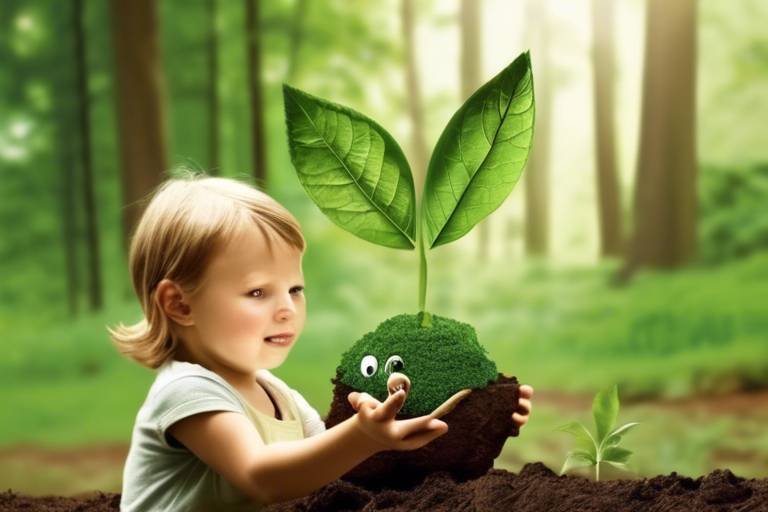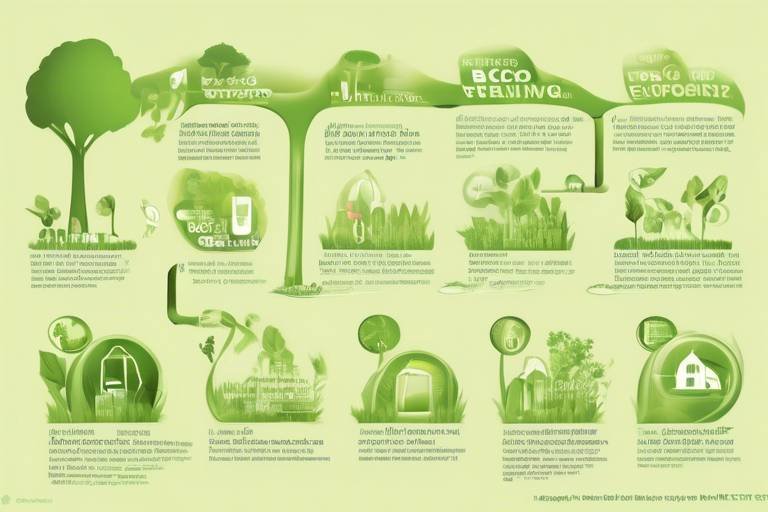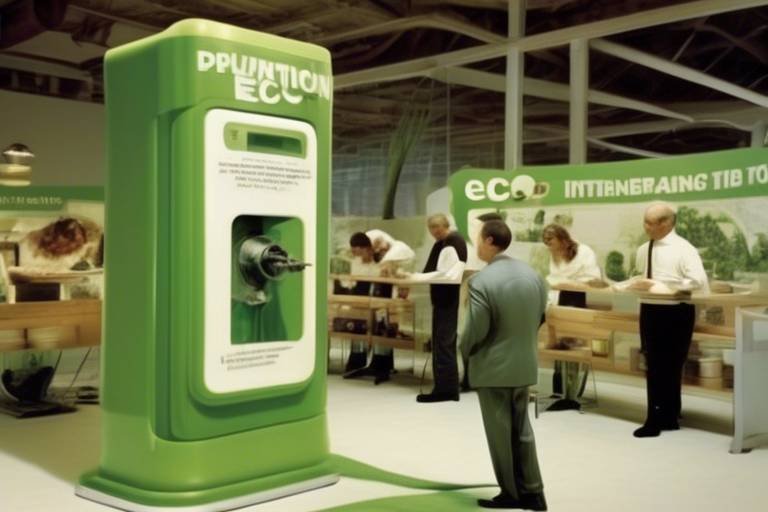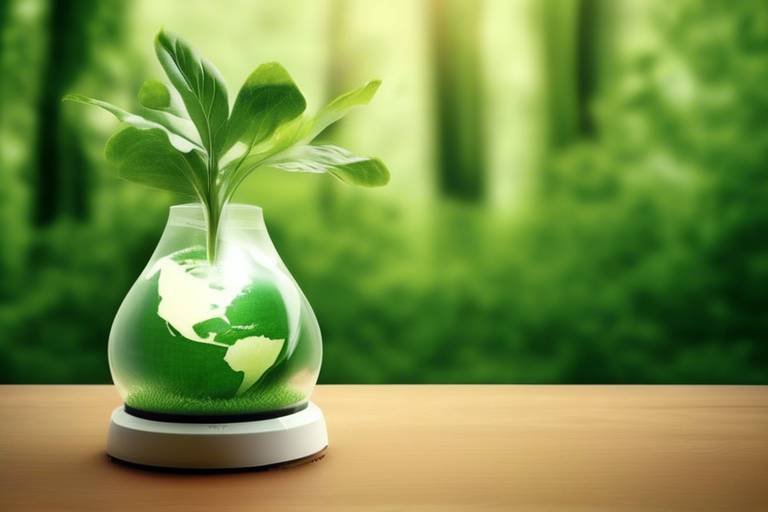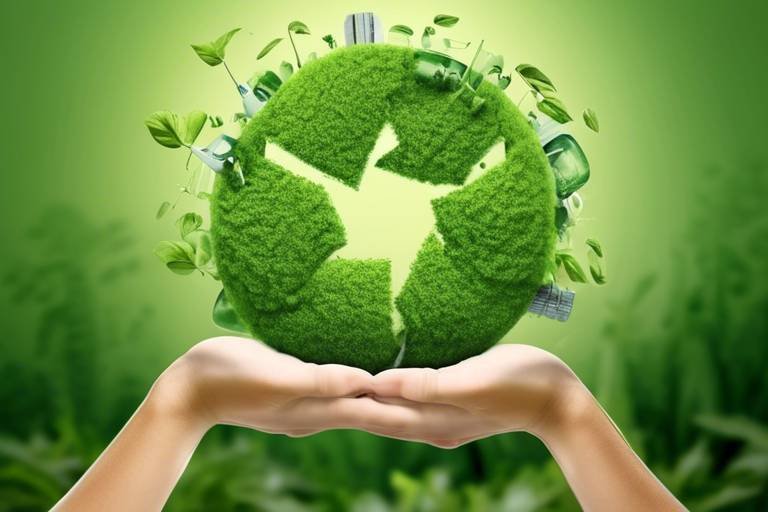Are There Truly Eco-Friendly Plastics?
In a world increasingly aware of environmental issues, the term eco-friendly plastics has become a hot topic. But what does it really mean? Are these materials a genuine solution to our plastic crisis, or are they just another marketing gimmick? As we dive into this fascinating subject, we'll unpack the composition, benefits, limitations, and ongoing debates surrounding eco-friendly plastics compared to their traditional counterparts. The quest for sustainability has led to innovative alternatives, but the question remains: can we truly rely on these materials to save our planet?
Understanding what qualifies as eco-friendly plastics is essential for anyone interested in making sustainable choices. These materials are typically distinguished by a few key characteristics that set them apart from conventional plastics. To start, eco-friendly plastics are often designed to be biodegradable, meaning they can break down naturally in the environment, unlike traditional plastics that can persist for hundreds of years. Additionally, many eco-friendly options are recyclable, allowing them to be reprocessed and reused instead of ending up in landfills. Furthermore, some are sourced from renewable materials, such as plants, which reduces our reliance on fossil fuels. By understanding these characteristics, we can better assess the true environmental impact of these plastics.
There are various types of eco-friendly plastics, each with unique properties and potential applications. Let's take a closer look at some of the most prominent categories:
- Bioplastics: These are derived from renewable sources like corn starch or sugarcane and are often designed to be biodegradable.
- Recycled Plastics: Made from post-consumer waste, these plastics help reduce the need for new plastic production and minimize waste.
- Innovative Materials: New technologies are constantly emerging, leading to the development of materials that aim to reduce environmental impact.
Bioplastics are a promising alternative to conventional plastics, derived from renewable resources rather than fossil fuels. Their production process often involves fermenting sugars from plants, which can significantly lower carbon emissions compared to traditional plastic manufacturing. One of the main advantages of bioplastics is their potential to be biodegradable, breaking down into natural substances when disposed of correctly. However, it's essential to recognize that not all bioplastics are created equal. Some may still require specific conditions to decompose effectively, which can complicate their disposal.
Compostable plastics are a subset of bioplastics that can break down in a composting environment, transforming into nutrient-rich compost. Unlike traditional plastics, which can linger in landfills for centuries, compostable plastics have the potential to return valuable nutrients to the soil. However, for them to fulfill this promise, they must be disposed of in the right conditions—typically in industrial composting facilities that maintain specific temperature and moisture levels. This highlights the importance of proper waste management in maximizing the environmental benefits of compostable plastics.
Recycled plastics play a vital role in reducing the demand for new plastic production. By reprocessing plastic waste, we can conserve resources and reduce greenhouse gas emissions associated with manufacturing. The recycling process involves collecting, sorting, and processing used plastics into new products. However, challenges remain, such as contamination of recyclable materials and the need for consumer education to improve recycling rates. Despite these hurdles, using recycled plastics in various industries offers significant advantages, including lower energy consumption and reduced environmental impact.
Despite their many benefits, eco-friendly plastics are not without limitations. One of the primary challenges is their production costs, which can be higher than traditional plastics due to the sourcing of renewable materials and the complexities of manufacturing processes. Additionally, some eco-friendly plastics may not perform as well as conventional options, raising concerns about their suitability for certain applications. Furthermore, to maximize their environmental benefits, proper disposal methods are crucial. If compostable plastics end up in landfills, they may not break down as intended, negating their advantages.
When contrasting eco-friendly plastics with traditional plastics, it's vital to analyze their environmental footprints and lifecycle impacts. Traditional plastics, while versatile and cost-effective, pose significant challenges due to their long decomposition times and reliance on fossil fuels. In contrast, eco-friendly options aim to mitigate these issues, but their effectiveness can vary widely based on factors such as production methods and disposal practices.
A life cycle analysis (LCA) evaluates the environmental impacts of plastics from production to disposal. Studies have shown that eco-friendly options generally have a lower environmental impact throughout their lifecycle compared to traditional plastics. However, the benefits can be diminished if these materials are not disposed of correctly. Understanding the full lifecycle of both types of plastics is essential for making informed choices about our consumption and waste practices.
Consumer attitudes towards eco-friendly plastics significantly influence their market success. While awareness of environmental issues is growing, misconceptions about eco-friendly plastics persist. Many consumers are unaware of the differences between biodegradable, compostable, and recyclable plastics, which can lead to confusion and mistrust. Education plays a crucial role in promoting sustainable alternatives and helping consumers make informed choices that align with their values.
Q: Are all eco-friendly plastics biodegradable?
A: No, not all eco-friendly plastics are biodegradable. Some are recyclable, while others are designed to break down under specific conditions.
Q: Can I compost all types of eco-friendly plastics?
A: Compostable plastics should only be composted in industrial facilities that can maintain the necessary conditions for decomposition.
Q: How do recycled plastics impact the environment?
A: Using recycled plastics can significantly reduce the need for new plastic production, conserving resources and lowering greenhouse gas emissions.

The Definition of Eco-Friendly Plastics
Understanding what qualifies as eco-friendly plastics is essential for both consumers and manufacturers alike. In a world grappling with the consequences of plastic pollution, the term "eco-friendly" has become a buzzword, but what does it really mean? At its core, eco-friendly plastics are designed to minimize environmental impact throughout their lifecycle. This includes how they are produced, what they are made from, and how they are disposed of.
One of the primary characteristics that distinguish eco-friendly plastics from conventional plastics is their biodegradability. Unlike traditional plastics, which can take hundreds of years to decompose, many eco-friendly options are engineered to break down more quickly in the environment. This means that they can return to nature without leaving a harmful residue. Additionally, eco-friendly plastics are often made from renewable resources, such as corn starch or sugarcane, rather than petroleum-based materials. This shift not only reduces reliance on fossil fuels but also supports agricultural industries.
Another important aspect is recyclability. While traditional plastics can be recycled, the process is often complicated and not always efficient. Eco-friendly plastics aim to simplify this process, making it easier for consumers to recycle and for manufacturers to repurpose materials. In many cases, these plastics are designed to be compatible with existing recycling systems, which can help reduce the overall demand for new plastic production.
However, it’s crucial to note that not all eco-friendly plastics are created equal. The term can encompass a wide range of materials, some of which may not be as environmentally beneficial as they seem. For example, certain bioplastics may still require specific conditions to break down, which are not always available in typical landfill settings. Therefore, understanding the nuances of these materials is key to making informed choices.
In summary, eco-friendly plastics are defined by their ability to reduce environmental harm through characteristics like biodegradability, renewable sourcing, and recyclability. By choosing these alternatives, consumers can contribute to a more sustainable future and help combat the plastic pollution crisis that threatens our planet.

Types of Eco-Friendly Plastics
When we think about plastics, the term "eco-friendly" might seem like an oxymoron. However, the world of plastics is evolving, and there are indeed types that strive to minimize environmental harm. Understanding these types is crucial for anyone looking to make more sustainable choices. Eco-friendly plastics can be broadly categorized into several types, each with its own unique properties and benefits. Let’s take a closer look at some of the most notable categories.
First up, we have bioplastics. These materials are derived from renewable sources like corn starch, sugarcane, or even potato starch. Unlike traditional plastics, which are petroleum-based, bioplastics offer a sustainable alternative. They are often designed to be biodegradable, meaning they can break down naturally over time. However, it’s important to note that not all bioplastics are created equal. Some require specific conditions to decompose effectively, while others may linger in the environment if not disposed of properly.
Next, let’s talk about compostable plastics. These are a subset of bioplastics that break down into natural substances under composting conditions. The beauty of compostable plastics lies in their ability to return nutrients to the soil, making them a fantastic option for food packaging and other applications where waste can be composted. However, they need to be disposed of in industrial composting facilities to decompose properly, which can be a limitation in areas lacking such facilities.
Another significant player in the eco-friendly plastic arena is recycled plastics. This type of plastic is made from post-consumer waste, which means it has already been used and discarded. By recycling plastics, we reduce the need for new raw materials and help divert waste from landfills. The recycling process itself can be a bit complex, involving collection, sorting, cleaning, and reprocessing. Despite the challenges, recycled plastics are increasingly being used in various industries, from fashion to construction. They not only help in reducing plastic waste but also lower carbon emissions associated with producing new plastics.
To illustrate the differences and benefits of these types of eco-friendly plastics, let’s take a look at the following table:
| Type of Eco-Friendly Plastic | Source | Biodegradability | Common Uses |
|---|---|---|---|
| Bioplastics | Renewable resources (e.g., corn, sugarcane) | Yes (varies by type) | Packaging, utensils, and films |
| Compostable Plastics | Biomass (e.g., cornstarch) | Yes (in composting facilities) | Food packaging, bags, and food service items |
| Recycled Plastics | Post-consumer waste | No (but reduces new production) | Clothing, containers, and construction materials |
Lastly, we also have innovative materials that combine various eco-friendly technologies. These might include plastics that incorporate natural fibers or additives that enhance biodegradability. While still in the experimental phase for many applications, these innovations hold promise for the future of sustainable materials.
In summary, the landscape of eco-friendly plastics is diverse and evolving. From bioplastics to recycled options, each type offers a unique approach to reducing our environmental footprint. However, it’s essential to remain informed about their properties and proper disposal methods to truly benefit from their eco-friendly claims. As consumers, our choices can drive demand for these sustainable alternatives, pushing industries toward greener practices. The more we understand, the better equipped we are to make choices that contribute to a healthier planet.
- What are bioplastics made from? Bioplastics are typically made from renewable resources such as corn starch, sugarcane, or even potatoes.
- Are compostable plastics the same as biodegradable plastics? No, compostable plastics break down in composting conditions, while biodegradable plastics may require different conditions to decompose.
- Can recycled plastics be reused? Yes, recycled plastics can be reprocessed into new products, significantly reducing the need for new plastic production.
- What is the biggest challenge facing eco-friendly plastics? One of the main challenges is the need for proper disposal methods to ensure they achieve their environmental benefits.

Bioplastics: A Sustainable Alternative
When we talk about bioplastics, we’re diving into a fascinating realm of materials that promise to change the way we think about plastic. Derived from renewable sources such as corn starch, sugarcane, and even potato peels, bioplastics are often touted as a more environmentally friendly alternative to traditional petroleum-based plastics. But what does this really mean for our planet? Let’s unpack the concept of bioplastics and see how they fit into the puzzle of sustainability.
One of the most compelling aspects of bioplastics is their potential to reduce our reliance on fossil fuels. By utilizing resources that can be replenished, bioplastics can help mitigate the environmental impact associated with extracting and processing oil. Imagine replacing the oil rigs and refineries with fields of corn and sugarcane. This shift not only lessens our carbon footprint but also supports agricultural economies. However, it's essential to note that not all bioplastics are created equal, and their environmental benefits can vary significantly based on their production processes.
Bioplastics can generally be classified into two categories: biodegradable and non-biodegradable. Biodegradable bioplastics are designed to break down into natural substances when exposed to certain conditions, such as moisture and microorganisms. This property makes them particularly appealing for applications such as packaging and single-use items. On the other hand, non-biodegradable bioplastics can still contribute to sustainability by being recyclable, thus extending their lifecycle and minimizing waste. Here’s a quick comparison:
| Type of Bioplastic | Source | Biodegradability | Common Uses |
|---|---|---|---|
| PLA (Polylactic Acid) | Corn starch | Biodegradable | Food packaging, disposable cutlery |
| PHA (Polyhydroxyalkanoates) | Microbial fermentation | Biodegradable | Medical devices, agricultural films |
| PET (Recycled Polyethylene Terephthalate) | Recycled plastic | Non-biodegradable | Bottles, containers |
But what about the applications? Bioplastics are already making waves in various industries. From food packaging that decomposes instead of lingering in landfills for centuries, to biodegradable bags that can break down in composting environments, the potential is enormous. However, it’s important to remain critical. The production of bioplastics can also lead to issues such as land use changes and food supply competition, which raises questions about their overall sustainability.
As we explore the future of bioplastics, it’s crucial to consider the balance between innovation and environmental responsibility. While bioplastics present a promising alternative, they are not a panacea for the plastic pollution crisis. They require careful management and a shift in consumer behavior towards proper disposal methods to ensure they fulfill their eco-friendly potential. So, the next time you reach for a plastic item, ask yourself: could this be a bioplastic? And if so, what are the implications of that choice?

Compostable Plastics Explained
When we talk about compostable plastics, we're diving into a fascinating realm of materials designed to break down into natural substances through the action of microorganisms. Unlike traditional plastics, which can linger in our environment for centuries, compostable plastics are engineered to decompose in composting facilities or even in home compost bins under the right conditions. This decomposition process is not just about disappearing; it’s about returning to the earth in a way that enriches the soil rather than polluting it.
So, how do these plastics work? Compostable plastics are typically made from renewable resources such as corn starch, potato starch, or even sugarcane. They can be categorized into two main types: those that are biodegradable and those that are specifically designed for composting. The key difference lies in the conditions required for decomposition. While biodegradable plastics may break down in various environments, compostable plastics require specific conditions found in a composting system, including moisture, oxygen, and adequate temperature.
One of the most exciting aspects of compostable plastics is their potential to address the ever-growing problem of plastic waste. According to recent studies, an estimated 300 million tons of plastic are produced globally each year, and a significant portion of that ends up in landfills or the ocean. By utilizing compostable plastics, we can significantly reduce the volume of waste that contributes to environmental degradation. Imagine a world where your single-use items could vanish into the soil, nourishing the earth instead of suffocating it!
However, it’s essential to understand that compostable plastics are not a one-size-fits-all solution. For them to be effective, they must be disposed of properly. This means they need to be placed in the right composting facilities, which are equipped to handle the specific conditions required for their decomposition. If they end up in a landfill where conditions are not suitable, they may not break down as intended, leading to the same environmental concerns we face with traditional plastics.
To highlight the benefits and challenges of compostable plastics, here’s a quick comparison:
| Aspect | Compostable Plastics | Traditional Plastics |
|---|---|---|
| Source | Renewable resources | Fossil fuels |
| Decomposition | Breaks down in composting conditions | Can take hundreds of years to decompose |
| Environmental Impact | Potentially lower if disposed of correctly | High due to pollution and waste |
In conclusion, compostable plastics offer a promising alternative to traditional plastics, but they come with their own set of challenges. As consumers, we must educate ourselves on the proper disposal methods and advocate for better composting facilities to ensure these innovative materials fulfill their potential. The journey towards a sustainable future is a shared responsibility, and understanding compostable plastics is a crucial step in that direction.
- What are compostable plastics made from? Compostable plastics are typically made from renewable resources such as corn starch, sugarcane, and other plant-based materials.
- How long does it take for compostable plastics to decompose? Under optimal composting conditions, compostable plastics can break down within a few months, returning to the soil as natural compost.
- Can compostable plastics be recycled? No, compostable plastics should not be recycled with traditional plastics. They require specific composting conditions to break down effectively.
- Are compostable plastics truly eco-friendly? While they offer environmental benefits, their effectiveness depends on proper disposal and composting practices.

Recycled Plastics and Their Impact
Recycled plastics are more than just a buzzword; they represent a significant step towards reducing our reliance on virgin materials and minimizing waste. When we talk about recycled plastics, we're referring to plastics that have been collected, processed, and transformed into new products. This process not only diverts waste from landfills but also conserves resources and reduces greenhouse gas emissions associated with the production of new plastics. Isn't it incredible to think that a simple plastic bottle can have a second life as a fleece jacket or even a new bottle?
The recycling process involves several stages, starting from collection and sorting to cleaning and reprocessing. Once collected, plastics are sorted by type, as different plastics have different properties and recycling processes. For instance, polyethylene terephthalate (PET) is commonly recycled and can be transformed into new bottles or textiles, while high-density polyethylene (HDPE) is often used for containers and piping. However, the journey of recycling isn't without its hurdles. Contaminated materials, lack of infrastructure, and fluctuating market prices can all impede the effectiveness of recycling programs.
One of the most significant impacts of using recycled plastics is the reduction in the demand for virgin plastic production. According to various studies, recycling one ton of plastic can save approximately 7.4 cubic yards of landfill space and reduce carbon emissions by an estimated 1.5 tons. This is a win-win for both the environment and the economy. By utilizing recycled materials, industries can lower their production costs and reduce their environmental footprints, making recycled plastics not just an eco-friendly choice but also a smart business decision.
However, it's essential to understand that recycled plastics do come with their own set of challenges. The quality of recycled materials can sometimes be inferior to virgin plastics, which may limit their applications. Additionally, the recycling process itself can be energy-intensive and may not always be as sustainable as we hope. To tackle these challenges, ongoing innovation in recycling technologies and practices is crucial. For instance, advancements in chemical recycling have the potential to break down plastics into their original monomers, allowing for a higher quality of recycled material that can be used in a broader range of applications.
In conclusion, while recycled plastics play a vital role in mitigating plastic pollution and conserving resources, they are not a silver bullet. The journey towards a sustainable future requires a multifaceted approach that includes reducing plastic consumption, improving recycling technologies, and promoting a circular economy where materials are reused and recycled continuously. As consumers, we can contribute by supporting products made from recycled materials and advocating for better recycling practices in our communities.
- What types of plastics can be recycled? Most common plastics, like PET and HDPE, can be recycled, but it's essential to check local recycling guidelines.
- How can I ensure I'm recycling correctly? Always clean and sort your recyclables according to local guidelines to avoid contamination.
- Are recycled plastics safe for food use? Yes, but ensure that the recycled plastic is labeled as food-safe and follows regulatory standards.
- What are the benefits of using recycled plastics? Using recycled plastics conserves resources, reduces landfill waste, and lowers carbon emissions.

Limitations of Eco-Friendly Plastics
While eco-friendly plastics hold promise for reducing our environmental footprint, they are not without their limitations. First and foremost, the production costs associated with these materials can be significantly higher than traditional plastics. This disparity often results in higher prices for consumers, which can deter widespread adoption. For instance, bioplastics, which are derived from renewable resources, typically require more expensive farming practices and processing techniques compared to their petroleum-based counterparts.
Moreover, the performance issues of eco-friendly plastics can be a significant hurdle. Many of these materials do not perform as well as conventional plastics in terms of durability and strength. For example, while compostable plastics are designed to break down under specific conditions, they may not be suitable for all applications, especially in demanding environments. This raises the question: can we truly rely on these alternatives when they might not meet the same standards?
Another critical aspect to consider is the disposal methods required for eco-friendly plastics. While they are designed to be more sustainable, improper disposal can negate their benefits. For instance, compostable plastics need to be processed in industrial composting facilities to break down effectively. If they end up in a landfill, they may take just as long to decompose as traditional plastics. This highlights the importance of having the right infrastructure in place to ensure these materials are disposed of correctly.
Additionally, there is a common misconception that all eco-friendly plastics are completely biodegradable or compostable. In reality, not all eco-friendly plastics decompose in the same way or within the same time frame. Some bioplastics can still take years to break down, depending on environmental conditions, leading to confusion among consumers who may believe they are making a more sustainable choice without fully understanding the implications.
Lastly, the availability of eco-friendly plastics can be limited, making it challenging for businesses to adopt these materials on a larger scale. As demand grows, manufacturers may struggle to keep up, leading to supply chain issues and potential market instability. This creates a cycle where consumers want more sustainable options, but the industry isn't quite ready to deliver.
In summary, while eco-friendly plastics present a more sustainable alternative to traditional plastics, they come with their own set of challenges. From higher production costs and performance issues to the need for proper disposal methods and limited availability, it's clear that we need to approach these materials with a critical eye. As we continue to explore innovative solutions, it's essential to remain informed and advocate for practices that genuinely benefit our planet.
- What are eco-friendly plastics? Eco-friendly plastics are materials designed to have a reduced environmental impact compared to traditional plastics, often made from renewable resources or designed to be biodegradable.
- Are all eco-friendly plastics biodegradable? No, not all eco-friendly plastics are biodegradable. Some may take a long time to decompose or require specific conditions to break down effectively.
- How do production costs compare between eco-friendly and traditional plastics? Production costs for eco-friendly plastics are generally higher due to the sourcing of renewable materials and the processes involved in their production.
- What happens if compostable plastics are disposed of in a landfill? If compostable plastics end up in a landfill, they may not decompose effectively, similar to traditional plastics, negating their environmental benefits.
- How can consumers support the use of eco-friendly plastics? Consumers can support eco-friendly plastics by choosing products made from these materials, advocating for better waste management systems, and educating themselves and others about sustainable practices.

Comparing Eco-Friendly Plastics to Traditional Plastics
When it comes to understanding the environmental impact of plastics, it's crucial to compare eco-friendly plastics with their traditional counterparts. While both types of plastics serve similar functions in our daily lives, their effects on the environment can be strikingly different. Traditional plastics, often derived from fossil fuels, contribute significantly to pollution and climate change. In contrast, eco-friendly plastics are designed with sustainability in mind, aiming to reduce the ecological footprint associated with plastic usage.
One of the primary differences lies in their production processes. Traditional plastics are made from non-renewable resources, which not only depletes natural reserves but also generates greenhouse gases during extraction and manufacturing. On the flip side, many eco-friendly plastics, such as bioplastics, are created from renewable materials like corn starch or sugarcane. This fundamental difference in sourcing leads to a notable reduction in carbon emissions, making eco-friendly options more appealing for a sustainable future.
Another aspect to consider is the lifecycle impact of each type of plastic. Traditional plastics can take hundreds of years to decompose, leading to the accumulation of waste in landfills and oceans. In contrast, many eco-friendly plastics are designed to be biodegradable or compostable, breaking down into natural substances under the right conditions. However, it’s important to note that not all eco-friendly plastics are created equal; some require specific industrial composting facilities to decompose effectively, which may not be widely available.
To illustrate this further, let’s take a look at a comparative table that outlines key characteristics of eco-friendly plastics versus traditional plastics:
| Characteristic | Eco-Friendly Plastics | Traditional Plastics |
|---|---|---|
| Source Material | Renewable resources (e.g., corn, sugarcane) | Fossil fuels (e.g., petroleum) |
| Biodegradability | Often biodegradable or compostable | Non-biodegradable |
| Environmental Impact | Lower carbon footprint | High carbon footprint and pollution |
| Recycling Potential | Varies; some can be recycled | Widely recyclable but often not |
In terms of consumer perception, eco-friendly plastics are gaining traction as more people become aware of the environmental issues associated with traditional plastics. However, misconceptions still exist. For instance, some consumers believe that all eco-friendly plastics are entirely harmless or that they can be disposed of like regular plastics. This misunderstanding can lead to improper disposal, negating the benefits of these materials. Therefore, education and awareness are essential in promoting the use of sustainable alternatives.
In conclusion, while eco-friendly plastics present a promising alternative to traditional plastics, they are not without their challenges. The key lies in understanding their properties, benefits, and limitations. By making informed choices and advocating for better waste management practices, we can collectively reduce our reliance on traditional plastics and move towards a more sustainable future.
- What are eco-friendly plastics made from? Eco-friendly plastics are typically made from renewable resources such as corn starch, sugarcane, or recycled materials.
- Are all eco-friendly plastics biodegradable? Not all eco-friendly plastics are biodegradable; some require specific conditions to break down effectively.
- Can eco-friendly plastics be recycled? Yes, many eco-friendly plastics can be recycled, but the recycling process may vary depending on the type of material.
- How do eco-friendly plastics impact the environment? Eco-friendly plastics generally have a lower carbon footprint and are designed to reduce waste and pollution compared to traditional plastics.

Life Cycle Analysis of Plastics
When we talk about the life cycle analysis (LCA) of plastics, we're diving into a comprehensive evaluation that encompasses every stage of a plastic's existence—from its initial production to its eventual disposal. This analysis is crucial for understanding the true environmental impact of both traditional and eco-friendly plastics. It’s like tracing the footprints of a plastic product throughout its entire journey on Earth.
At the heart of LCA are several key phases:
- Raw Material Extraction: This is where it all begins. Traditional plastics are predominantly derived from fossil fuels, which involve significant energy consumption and environmental degradation. In contrast, eco-friendly plastics often utilize renewable resources, such as corn or sugarcane, which can mitigate some of these impacts.
- Manufacturing: The production process for both types of plastics requires energy and resources. However, eco-friendly plastics may have a lower carbon footprint during this phase due to their renewable sourcing.
- Usage: The functionality of plastics during their use phase is an important consideration. Eco-friendly plastics, especially bioplastics, may not always match the durability and versatility of traditional plastics, which can influence consumer choices and waste generation.
- Disposal: This is where the differences become stark. Traditional plastics can take hundreds of years to decompose, while some eco-friendly options are designed to break down more quickly under specific conditions. However, if compostable plastics end up in a landfill, they may not decompose effectively, leading to misconceptions about their environmental benefits.
A life cycle analysis not only highlights these stages but also quantifies the environmental impacts associated with each. For instance, a recent study comparing the life cycle impacts of traditional plastics and bioplastics revealed fascinating insights:
| Impact Category | Traditional Plastics | Bioplastics |
|---|---|---|
| Greenhouse Gas Emissions (kg CO2e) | 6.0 | 3.5 |
| Energy Consumption (MJ) | 80 | 50 |
| Water Usage (liters) | 1000 | 600 |
This table illustrates that while bioplastics show promise in reducing greenhouse gas emissions and energy consumption, they still face challenges in water usage and other environmental factors. It’s a complex balancing act that requires careful consideration.
Ultimately, the LCA of plastics serves as a vital tool for consumers, manufacturers, and policymakers alike. By understanding the life cycle of these materials, we can make more informed decisions about which products to support and how to improve their sustainability. As we continue to innovate and seek out better alternatives, the insights gained from life cycle analysis will be instrumental in guiding us towards a more sustainable future.
Q: What is life cycle analysis (LCA)?
A: Life cycle analysis (LCA) is a method used to assess the environmental impacts associated with all stages of a product's life, from raw material extraction through production, use, and disposal.
Q: How does LCA help in choosing eco-friendly plastics?
A: LCA provides a comprehensive view of the environmental impacts of different plastics, helping consumers and companies make informed choices about which materials are truly sustainable.
Q: Are bioplastics always better for the environment than traditional plastics?
A: Not necessarily. While bioplastics can have lower greenhouse gas emissions, their overall environmental impact depends on various factors, including how they are produced and disposed of.
Q: What happens if compostable plastics are not disposed of correctly?
A: If compostable plastics end up in a landfill, they may not decompose effectively, which can lead to misconceptions about their environmental benefits.

Consumer Perception and Acceptance
When it comes to eco-friendly plastics, consumer perception plays a pivotal role in their acceptance and usage. Many people are becoming increasingly aware of the environmental issues associated with traditional plastics, and this awareness is shaping their purchasing decisions. However, there remains a significant gap between awareness and action. While consumers express a desire to support sustainable products, their choices often don't align with their intentions. For instance, a survey might reveal that 70% of respondents claim they would pay more for eco-friendly products, yet the actual sales figures tell a different story. This discrepancy raises the question: what’s holding consumers back?
One of the primary factors influencing consumer perception is misinformation. Many individuals are unaware of the differences between various types of eco-friendly plastics, such as bioplastics and recycled plastics. This confusion can lead to skepticism. For example, some consumers might believe that all eco-friendly plastics are biodegradable, when in reality, not all are designed to break down in natural environments. This misconception can deter them from choosing these products, as they may feel uncertain about their actual environmental benefits.
Additionally, branding and marketing play critical roles in shaping consumer attitudes. Brands that effectively communicate the benefits of eco-friendly plastics, along with transparent information about their sourcing and production processes, tend to gain consumer trust. A well-crafted marketing campaign can highlight the positive impacts of choosing eco-friendly options, making it easier for consumers to feel good about their purchases. On the flip side, brands that fail to convey this information may struggle to convince consumers of the value of their sustainable products.
Another aspect to consider is the price point. Eco-friendly plastics often come with a higher price tag compared to their traditional counterparts. This can be a significant barrier for many consumers, especially in a world where budget constraints are common. To overcome this challenge, companies need to find ways to reduce production costs and make eco-friendly options more accessible. If consumers perceive that the benefits outweigh the costs, they are more likely to make the switch.
Moreover, the role of education cannot be overstated. Public awareness campaigns that inform consumers about the importance of reducing plastic waste and the benefits of eco-friendly plastics can significantly influence acceptance. When consumers understand how their choices impact the environment, they may be more inclined to choose sustainable options. Educational initiatives can take various forms, including workshops, social media campaigns, and partnerships with environmental organizations, all aimed at demystifying eco-friendly plastics.
In conclusion, while there is a growing interest in eco-friendly plastics, several factors influence consumer perception and acceptance. Misinformation, branding, pricing, and the need for education all play essential roles in shaping how consumers view these sustainable alternatives. As we continue to navigate the complexities of plastic use and waste, it is crucial for companies and organizations to address these challenges head-on, fostering a more informed and engaged consumer base.
- What are eco-friendly plastics? Eco-friendly plastics are materials designed to have a lower environmental impact than traditional plastics, often being biodegradable or made from renewable resources.
- Are all eco-friendly plastics biodegradable? No, not all eco-friendly plastics are biodegradable. Some are recyclable or made from recycled materials but do not break down naturally.
- Why are eco-friendly plastics often more expensive? The production processes for eco-friendly plastics can be more costly, and they may require specialized materials or technologies that drive up prices.
- How can I support the use of eco-friendly plastics? You can support eco-friendly plastics by choosing products made from these materials, educating yourself and others about their benefits, and advocating for policies that promote sustainable practices.
Frequently Asked Questions
- What are eco-friendly plastics?
Eco-friendly plastics are materials designed to minimize environmental impact. They often come from renewable resources, are biodegradable, or are recyclable, making them a more sustainable option compared to traditional plastics.
- How do bioplastics differ from conventional plastics?
Bioplastics are made from natural materials, like corn or sugarcane, and are often designed to biodegrade over time. In contrast, conventional plastics are typically derived from fossil fuels and can take hundreds of years to decompose.
- Are all eco-friendly plastics biodegradable?
No, not all eco-friendly plastics are biodegradable. While some, like compostable plastics, break down in specific conditions, others, like recycled plastics, are designed for reuse rather than decomposition.
- What are the main benefits of using recycled plastics?
Using recycled plastics reduces the need for new plastic production, conserves natural resources, and decreases energy consumption. It also helps divert waste from landfills, contributing to a more sustainable environment.
- What challenges do eco-friendly plastics face?
Eco-friendly plastics can be more expensive to produce, may not perform as well as traditional plastics in all applications, and require proper disposal methods to ensure their environmental benefits are realized.
- How do consumer perceptions affect eco-friendly plastics?
Consumer perceptions play a significant role in the market success of eco-friendly plastics. Misconceptions and lack of awareness can hinder adoption, making education and transparency essential for promoting sustainable alternatives.
- What is a life cycle analysis of plastics?
A life cycle analysis evaluates the environmental impacts of plastics throughout their entire life, from production to disposal. It helps compare eco-friendly options to traditional plastics in terms of their overall sustainability.




